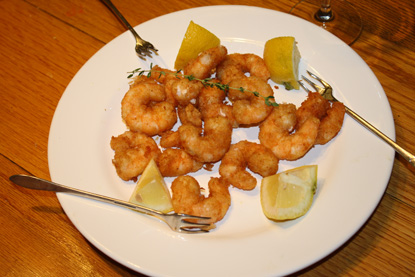















Soul Food
The Culinary Diversity of the Mississippi Gulf Coast
The Mississippi Gulf Coast is as different from the red clay hills of northern Mississippi and the alluvial plains of the Delta as moonshine and buttermilk, and the differences are far more than just that of geological distinction. The divide runs along religious lines, economic base and social and cultural heritage, and most Coast residents think that the culinary rift is vast. When did someone in north Mississippi ever know how to make a decent oyster stew or crab cake?
The Coast shares a deep kinship with New Orleanians and their Creole forefathers, and isn't even a kissing cousin of Jackson or Hattiesburg or Tupelo. If you lived in Biloxi any time within the first one hundred years of its founding, you were most likely a French Catholic and ate fish every Friday, and the fish would have been caught in saltwater. The economic engine that has driven the area for most of its existence comes from the sea---seafood, shipping or, on occasion, smuggling rum from Cuba---and has absolutely nothing to do with walking behind a plow and a cantankerous mule. Immigrants who came to the Coast after the French were Spanish, Yugoslavian, Irish and Cajun French from Louisiana. The next wave of newcomers seeking the American dream was made up of Vietnamese fishermen, who came to the area in the late twentieth century. The Coast has always been a tolerant community, willing to accept diversity.
Long before the days of the Interstate Highway System, a gentleman and his family living in New Orleans who sought to escape the city's stifling summer heat would take a streetcar up Canal Street to Lake Pontchartrain and board a steamer that would take them across the lake, out the Rigolets and into the shallow Mississippi Sound. Once heading east along the Mississippi coast, long piers would reach out from hotels and private homes alike into water deep enough for the boats to approach. The hotels served the expected Creole-influenced food, and the wealthy families brought along their very talented cooks from home. The culinary influence has lasted till this day. Each succeeding wave of immigrants left their culinary mark to some extent, but the Creole base remains well established.
Much has changed on the Coast over the years. Hurricanes have battered many homes and businesses into kindling. British Petroleum's oil spill resulting from an April 20, 2010 explosion at the Deepwater Horizon drilling rig has done as yet unknown damage. And a pale economy continues to cause suffering. But nothing has changed the people's love for the abundant and very safe seafood that comes from the Mississippi Sound and Gulf of Mexico.
Restaurants still serve rich gumbos and po' boys filled with all manner of things. Flounder are stuffed with fat blue crab, red fish are turned into court-bouillon (prounounced coo-be-on) and oysters and huge shrimp are fried and served in piles. Some recipes reflect the cultural diversity, and none does so more than gumbo, which was influenced by French, Spanish, Native American and African cultures. Shrimp and grits admits some connection with the rest of the South where grits are more common, and shrimp boat spaghetti (tomato sauce, shrimp and pasta served as a very economical meal by fishermen on their boats and at home) testifies not only to other cultural influences but a certain inventiveness of poor people taking advantage of what is at hand.
My favorite recipe of this sort of cultural mix is a method of frying shrimp and oysters taught to me by a Vietnamese friend. It can be applied to almost anything that is suitable for frying.
The Coast shares a deep kinship with New Orleanians and their Creole forefathers, and isn't even a kissing cousin of Jackson or Hattiesburg or Tupelo. If you lived in Biloxi any time within the first one hundred years of its founding, you were most likely a French Catholic and ate fish every Friday, and the fish would have been caught in saltwater. The economic engine that has driven the area for most of its existence comes from the sea---seafood, shipping or, on occasion, smuggling rum from Cuba---and has absolutely nothing to do with walking behind a plow and a cantankerous mule. Immigrants who came to the Coast after the French were Spanish, Yugoslavian, Irish and Cajun French from Louisiana. The next wave of newcomers seeking the American dream was made up of Vietnamese fishermen, who came to the area in the late twentieth century. The Coast has always been a tolerant community, willing to accept diversity.
Long before the days of the Interstate Highway System, a gentleman and his family living in New Orleans who sought to escape the city's stifling summer heat would take a streetcar up Canal Street to Lake Pontchartrain and board a steamer that would take them across the lake, out the Rigolets and into the shallow Mississippi Sound. Once heading east along the Mississippi coast, long piers would reach out from hotels and private homes alike into water deep enough for the boats to approach. The hotels served the expected Creole-influenced food, and the wealthy families brought along their very talented cooks from home. The culinary influence has lasted till this day. Each succeeding wave of immigrants left their culinary mark to some extent, but the Creole base remains well established.
Much has changed on the Coast over the years. Hurricanes have battered many homes and businesses into kindling. British Petroleum's oil spill resulting from an April 20, 2010 explosion at the Deepwater Horizon drilling rig has done as yet unknown damage. And a pale economy continues to cause suffering. But nothing has changed the people's love for the abundant and very safe seafood that comes from the Mississippi Sound and Gulf of Mexico.
Restaurants still serve rich gumbos and po' boys filled with all manner of things. Flounder are stuffed with fat blue crab, red fish are turned into court-bouillon (prounounced coo-be-on) and oysters and huge shrimp are fried and served in piles. Some recipes reflect the cultural diversity, and none does so more than gumbo, which was influenced by French, Spanish, Native American and African cultures. Shrimp and grits admits some connection with the rest of the South where grits are more common, and shrimp boat spaghetti (tomato sauce, shrimp and pasta served as a very economical meal by fishermen on their boats and at home) testifies not only to other cultural influences but a certain inventiveness of poor people taking advantage of what is at hand.
My favorite recipe of this sort of cultural mix is a method of frying shrimp and oysters taught to me by a Vietnamese friend. It can be applied to almost anything that is suitable for frying.
Saigon-style Gulf Coast Shrimp
1-2 pounds of large shrimp (shells off) or 1 quart of oysters still in their liquor (drained just before cooking)
12-ounce bag of dry tempura batter
6-ounce bag of Panko bread crumbs (Japanese-style)
Fresh ground pepper
Tony Chachere's Seasoning
1-2 pounds of large shrimp (shells off) or 1 quart of oysters still in their liquor (drained just before cooking)
12-ounce bag of dry tempura batter
6-ounce bag of Panko bread crumbs (Japanese-style)
Fresh ground pepper
Tony Chachere's Seasoning

Fill a deep black iron skillet no more than halfway with good, clean oil and heat to 350 degrees. Place the tempura and panko in separate bowls. Season the tempura aggressively with the pepper and Tony Chachere's Seasoning. Toss the shrimp or oysters a few at a time in the tempura and set aside. Let them sit until their natural moisture has soaked through the powder coating, but if you are in a rush you can spritz them with water. When they are gummy, toss them in the panko until well coated.
Please read this carefully: Fry a few shrimp or oysters at a time so that when added to the oil the temperature does not nosedive, and do not overcook. Shrimp and oysters are done to perfection in sixty to one hundred seconds. Every second they are cooked past their prime causes deterioration. Remove from oil and drain on paper towels or on a brown paper sack taken apart and made to lay flat.
Quick Dipping Sauce
Place into a food processor 1 cup of mayonnaise, the juice of a lemon and a 1/4 cup of cilantro. Blend until smooth and serve cold. Always serve with wedges of fresh cut lemon.
Please read this carefully: Fry a few shrimp or oysters at a time so that when added to the oil the temperature does not nosedive, and do not overcook. Shrimp and oysters are done to perfection in sixty to one hundred seconds. Every second they are cooked past their prime causes deterioration. Remove from oil and drain on paper towels or on a brown paper sack taken apart and made to lay flat.
Quick Dipping Sauce
Place into a food processor 1 cup of mayonnaise, the juice of a lemon and a 1/4 cup of cilantro. Blend until smooth and serve cold. Always serve with wedges of fresh cut lemon.
BIBLIOGRAPHY
Charles L. Sullivan, The Mississippi Gulf Coast: Portrait of a People (Northside, California: Windsor Publications, Inc., 1985).
Author: Julian G. Brunt. Published September 9, 2010.
Charles L. Sullivan, The Mississippi Gulf Coast: Portrait of a People (Northside, California: Windsor Publications, Inc., 1985).
Author: Julian G. Brunt. Published September 9, 2010.
Copyright
Southern Edition
All Rights Reserved
Southern Edition
All Rights Reserved
All materials contained on this site, including text and images, are protected by copyright laws and may not be reproduced without prior written permission from the publisher. Where applicable, use of some items contained on this site may require permission from other copyright owners.
Fair Use of text from SouthernEdition.com is permitted to the extent allowed by copyright law. Proper citation is requested. Please use this guide when citing a Southern Edition article.
Contact Greg Freeman or SouthernEdition.comFair Use of text from SouthernEdition.com is permitted to the extent allowed by copyright law. Proper citation is requested. Please use this guide when citing a Southern Edition article.
